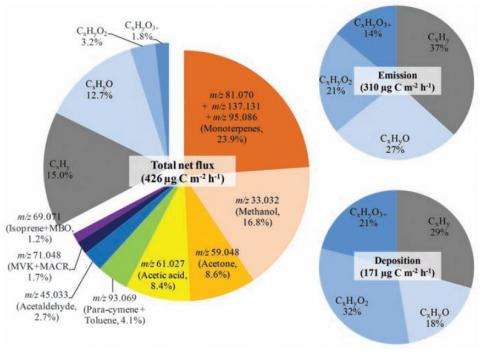August 9, 2013 report
Researchers devise a way to measure volatile organic compound exchange in the atmosphere

(Phys.org) —A team of researchers from the U.S., the Netherlands, and Italy has found a way to detect and measure the exchange of volatile organic compounds (VOCs) in the atmosphere. In their paper published in the journal Science, the team describes how they used a new technique to measure VOC concentrations in the air above an orange grove in California.
VOCs are organic chemicals that exhibit high vapor pressure under normal conditions. Their high vapor pressure tendencies are due to their low boiling point, which in turn result in their molecules evaporating and winding up in the atmosphere. Prior research has shown that there are a large number of such chemicals in the atmosphere, but environmental conditions have made it difficult to isolate and identify these chemicals from any given sample. For that reason, researchers have primarily focused almost exclusively on a chosen few, such as isoprene, methanol, and various terpenes. In this new effort, the team has put together two devices that allow not only for monitoring all of the VOCs that exist in the air at a certain location, but also whether the VOCs are being emitted or deposited.
Neither device is new, they are just being used in a new way. The first is a mass spectrometer. The team installed it atop a pole at Gordon Ranch along with gas inlets and an anemometer. The spectrometer collects chemical samples while the anemometer detects changes in wind direction. This combination allows the team to discern if readings picked up by the spectrometer are from chemicals being put into the air (wind moving upwards) or taken out (wind moving downward). This novel arrangement allows the researchers to monitor the total exchange of VOCs in the air above the orange grove for a short period of time.
Going in, the team expected to find a few new compounds in the air—they were surprised, however, to find they had detected hundreds of VOCs. Their effort marks the first time a research team has been able to identify the entire exchange of VOCs in a portion of the atmosphere.
The team notes that their research effort was limited to one site and that monitoring other sites could result in vastly different findings. More importantly, it appears their technique could be used to monitor sites all around the world, giving environmental scientists much more information about what is going on in the atmosphere, including of course, global warming.
More information: Active Atmosphere-Ecosystem Exchange of the Vast Majority of Detected Volatile Organic Compounds, Science 9 August 2013: Vol. 341 no. 6146 pp. 643-647 DOI: 10.1126/science.1235053
ABSTRACT
Numerous volatile organic compounds (VOCs) exist in Earth's atmosphere, most of which originate from biogenic emissions. Despite VOCs' critical role in tropospheric chemistry, studies for evaluating their atmosphere-ecosystem exchange (emission and deposition) have been limited to a few dominant compounds owing to a lack of appropriate measurement techniques. Using a high–mass resolution proton transfer reaction–time of flight–mass spectrometer and an absolute value eddy-covariance method, we directly measured 186 organic ions with net deposition, and 494 that have bidirectional flux. This observation of active atmosphere-ecosystem exchange of the vast majority of detected VOCs poses a challenge to current emission, air quality, and global climate models, which do not account for this extremely large range of compounds. This observation also provides new insight for understanding the atmospheric VOC budget.
Journal information: Science
© 2013 Phys.org


















